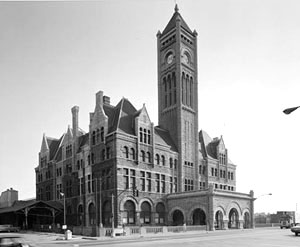
Nashville Union Station
This National Historic Landmark symbolizes the power of railroad companies, specifically the Louisville and Nashville (L&N) Railroad, over the transportation and economy of turn-of-the-century Tennessee. Built between 1898 and 1900, and designed by L&N company engineer Richard Montfort, the building is a significant Tennessee example of Richardsonian Romanesque style. The magnificent passenger train shed, which measured 250 by 500 feet with a clear span of 200 feet, was an engineering marvel for its time. In 1900 it was the longest single-span, gable roof structure in the country. After a fire damaged the shed, and no viable preservation alternatives were identified, the shed was razed in late 2000.
For seven decades, Union Station served Nashville passengers as a massive stone gateway to the metropolitan corridor represented by the national rail system. In 1975 the station was condemned and closed; Amtrak continued to use the shed for passenger traffic until 1979. Metropolitan Nashville officials acquired the rapidly deteriorating structure in 1985; by the following year, Union Station had been restored as a hotel and restaurant. It has served that function ever since and once again is a prominent Nashville architectural and historical landmark.



